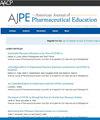Impact of a Flipped Classroom on Evidence-Based Medicine Skills Among Pharmacy Students
IF 3.5
4区 教育学
Q1 EDUCATION, SCIENTIFIC DISCIPLINES
引用次数: 0
Abstract
Objective
In 2020, the lecture series for a written clinical inquiry (CI) assignment (ie, drug information papers) transitioned to a flipped model using asynchronous presentations with preclass assignments, followed by synchronous discussions with active learning. The objective of this evaluation was to determine the impact of a flipped instructional model on pharmacy students’ evidence-based medicine (EBM) skills using CI scores.
Methods
A report of CI scores was generated for the 2019 third-year (P3) class (lecture) and the 2020 and 2021 P3 classes (flipped) as well as for Block 1 Advanced Pharmacy Practice Experience (APPE) CI scores. Clinical questions were assigned by faculty to P3 students, while preceptors assigned questions on APPEs. The CI rubric includes 3 major subscores: appropriate literature, evidence summary, and evidence-based answer, each contributing 25% of the total score.
Results
There were 139 and 259 students in the lecture and flipped cohorts, respectively. In the flipped cohort, the mean overall CI scores improved in both the P3 and APPE years compared to the lecture cohort (mean change: 4.2% and 6.7%, respectively). The major subscores statistically significantly increased in the flipped model for both P3 and APPE assignments, except for a nonsignificant increase in the P3 evidence-based answer subscore. Improvements were primarily observed in the skills emphasized during in-class active learning.
Conclusion
Meaningful increases in CI scores were observed using a flipped model compared to a lecture-based model, especially in skills reinforced by in-class active learning. A flipped model can improve skills with translation to practice-based settings.
翻转课堂对药学学生循证医学技能的影响。
目的:2020年,临床调查(CI)书面作业(即药物信息论文)的系列讲座转变为翻转模式,使用异步演讲和课前作业,然后同步讨论和主动学习。本评估的目的是使用CI分数来确定翻转教学模式对药学学生循证医学(EBM)技能的影响。方法:生成2019年三年级(P3)班(讲座)、2020年和2021年P3班(翻转)的CI分数报告以及block 1 APPE CI分数报告。临床问题由教师分配给P3学生;导师分配高级药学实践轮岗(APPES)的问题。CI分类包括恰当文献、证据总结和循证答案3个主要子得分,每个子得分占总分的25%。结果:讲座组学生139人,翻转组259人。在翻转队列中,与讲课队列相比,P3和APPE年的平均总体CI得分均有所提高(平均变化分别为4.2%和6.7%)。翻转模式的P3和APPE作业的主要分项得分均有统计学意义上的显著提高,除了P3循证答案分项得分无显著提高。改善主要体现在课堂主动学习中强调的技能上。结论:与讲课相比,使用翻转模式的CI得分显著提高,尤其是在课堂主动学习强化的技能方面。翻转模型可以提高翻译技能,以实践为基础。
本文章由计算机程序翻译,如有差异,请以英文原文为准。
求助全文
约1分钟内获得全文
求助全文
来源期刊
CiteScore
4.30
自引率
15.20%
发文量
114
期刊介绍:
The Journal accepts unsolicited manuscripts that have not been published and are not under consideration for publication elsewhere. The Journal only considers material related to pharmaceutical education for publication. Authors must prepare manuscripts to conform to the Journal style (Author Instructions). All manuscripts are subject to peer review and approval by the editor prior to acceptance for publication. Reviewers are assigned by the editor with the advice of the editorial board as needed. Manuscripts are submitted and processed online (Submit a Manuscript) using Editorial Manager, an online manuscript tracking system that facilitates communication between the editorial office, editor, associate editors, reviewers, and authors.
After a manuscript is accepted, it is scheduled for publication in an upcoming issue of the Journal. All manuscripts are formatted and copyedited, and returned to the author for review and approval of the changes. Approximately 2 weeks prior to publication, the author receives an electronic proof of the article for final review and approval. Authors are not assessed page charges for publication.

 求助内容:
求助内容: 应助结果提醒方式:
应助结果提醒方式:


